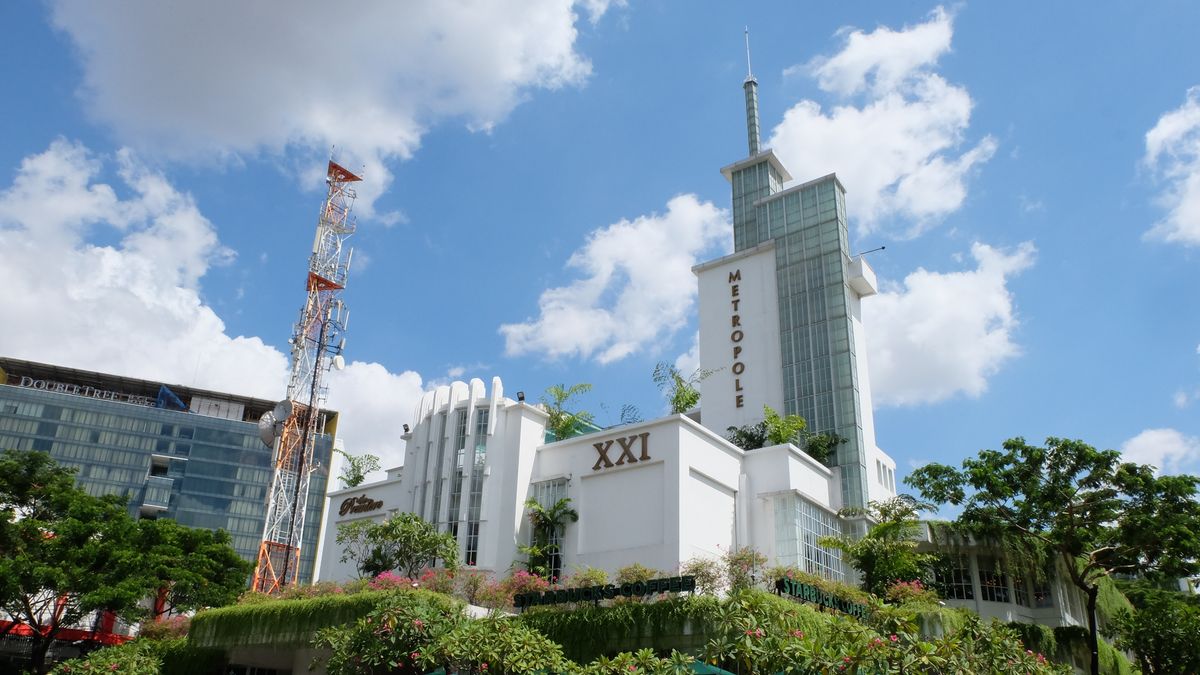JAKARTA - Historically, film entertainment entered the Dutch East Indies at the end of 1900. At that time, the presence of domestic films had to compete with other entertainments, such as European toniles, Malay toniles, plays, and wayang performances. As a result, film entertainment was not very popular because most of it was only in the form of documentaries which tended to be less popular at that time.
Then, when storytelling films began to invade Indonesia with good actors and stories, things began to change. In Jakarta, the Metropole cinema - which is usually known as Megaria - is proof that film entertainment is starting to be equal to other entertainment. Interestingly, Metropole has now become the oldest cinema that still survives in the jungle of the Capital City.
Although not the first cinema in Jakarta, the presence of Metropole, which was built on August 11, 1949 and completed in 1951, is considered special. One of the things that makes it interesting is the cinema building with an art deco nuance, which is a building style that developed after World War II. The main characteristic of art deco style is that the building has a cubist style, futuristic, geometric, and tower.
Many people think that the Metropole is the design of the Dutch architect, Johannes Martinus (Han) Groenewegen. In fact, according to a number of historical records, the designer of the Metropole building was Liauw Goan Seng.
Metropole had earned the title as the most comfortable cinema of its time. It is recorded that 1,446 viewers can be accommodated in the cinema. What's more, the cinema is also equipped with a blower and exhaust which adds to the appeal of people to come. On the top floor of the building there is also a dance hall. Meanwhile, on the right side of the cinema is filled with textile shops.
Not surprisingly, on the day of its inauguration, a number of large guests attended. Some of them are Rahmi Rachim, wife of Vice President Mohammad Hatta; Sultan Hamengkubuwono IX; to Haji Agus Salim. The film, which was screened for the first time, was no less special because it presented a film produced by George Sidney's Metro Goldwyn Mayer (MGM), Annie Get Your Gun (1950).
Furthermore, Metropole only played foreign films produced by MGM which was known for producing colossal films, such as Ben Hur (1959) to Cleopatra (1963). Therefore, films are still dominated by foreign films. This condition does not only happen in Metropole. Rosihan Anwar in the book Small History of Indonesia "Petite Histoire" Volume 2 (2009), explains, of the six hundred cinemas in Indonesia, domestic films only receive a portion of 15 percent of the total films aired.
"The distribution is practically controlled by American films and Indonesian producers do not fantasize that it will be easy for them to be shown in first-class cinemas. Only the film PT. Perfini, Krisis (1953) which was successfully screened in the Metropole cinema, Jakarta thanks to its good quality and strong appeal to the audience. Cinema entrepreneurs prioritize American films over Indonesian films, "said Rosihan Anwar.
The famous MetropoleThe name Metropole soon changed to Megaria. The euphoria of the revolution made the spirit of Indonesian nationalism rise. Because of this, foreign names began to be replaced with names that had local tones.
Quoted from Dwi Wiyana's writing in Tempo Magazine entitled Megaria, Not Just Memories (2007), during its heyday in the 1950-1980s, Megaria had become part of the urban lifestyle of Jakarta children. "The upper middle class in Jakarta watched the legendary film War and Peace by Leo Tolstoy," he wrote.
"Or the classic, Gone with the Wind in Metropole. The action of blonde Marilyn Monroe or Robert Mitchum can also be enjoyed in the art deco-style cinema with a capacity of 1,500 seats."
Megaria is not just a place to watch the cinema. Those who watch can also meet celebrity idols and political figures at Megaria. Just mention the names that often appear, like Citra Dewi or Rima Melati and even the ministers.
Anyone who has visited Megaria at that time will undoubtedly be filled with pride. Especially, for those who have tried watching movies in a lodge class. "Loge is first class, with a ticket price during the matinee show - cheap Saturday afternoon shows - Rp. 4 per person or the equivalent of Rp. 15 thousand today."
Even so, Megaria's glory was dim when she entered the early 1980s. Megaria, which was originally a favorite entertainment place for Jakartans, is threatened with losing competition. The number of cinemas has increased rapidly by a fantastic number reaching 162. In addition, the rise of television shows, video rental - both original and pirated - is increasingly overwhelming Megaria. Fortunately, Megaria managed to get past that with an average audience size of 30 percent of the total seat capacity.
In 2007, word got out that the Megaria cinema which is more than half a century old wants to be sold on a property buying and selling site. Various offers had arrived. There are those who want to build roads to those who want to build shopping centers. Many people worry that the story of Megaria will end there.
Luckily, the Jakarta Culture and Museum Office emphasized that it would not allow the demolition of the building to occur. Even if the new owner will change the use of the building or build the surrounding area, he must obtain permission from the Jakarta City Culture and Museum Museum Restoration Session Team.
Presumably, those are the ups and downs of cinema that have filled the happiness of many Jakarta residents. Uniquely, Megaria is still entertaining Jakarta residents. However, the name Megaria has changed back to Metropole 21. The additional number 21 indicates that this cinema was managed by the 21 Cineplex network in 1986. Then, it changed back to Metropole XXI.
The English, Chinese, Japanese, Arabic, and French versions are automatically generated by the AI. So there may still be inaccuracies in translating, please always see Indonesian as our main language. (system supported by DigitalSiber.id)










